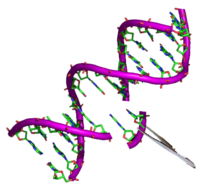
Photo from wikipedia
Abstract Aim: Hemophilia A is a genetic, chronic disorder classified by deficient or defective coagulation factor VIII (FVIII) that puts those affected at risk for spontaneous bleeding episodes, which lead… Click to show full abstract
Abstract Aim: Hemophilia A is a genetic, chronic disorder classified by deficient or defective coagulation factor VIII (FVIII) that puts those affected at risk for spontaneous bleeding episodes, which lead to joint damage and chronic pain over time. Currently, most severe hemophilia A patients are treated with prophylactic FVIII, which requires costly and frequent infusions and life-long adherence to medication. A gene therapy (valoctocogene roxaparvovec) is currently in development for the treatment of severe hemophilia A. This model assessed the potential cost-effectiveness of treating patients with valoctocogene roxaparvovec rather than prophylactic therapy. Materials and methods: We developed an individual-based, state-transition microsimulation model for assessing the likely cost-effectiveness of valoctocogene roxaparvovec compared to prophylactic FVIII. Men aged 30 with severe hemophilia A were modeled over a lifetime horizon, and costs were reported from the perspective of the United States health care system. Through microsimulation, patient-level heterogeneity was captured in starting weight, starting Pettersson score (PS), durability of valoctocogene roxaparvovec, and annual bleed rate (ABR). Results: The model projects that treatment with single-administration valoctocogene roxaparvovec would be cost-saving to people with hemophilia A at a price point comparable to other currently available gene therapy products due to its potential to reduce FVIII utilization, direct medical costs, lifetime bleeds, and accumulated joint damage. Limitations: The model relies upon evidence-based assumptions for clinical inputs due to limited data availability. Such uncertainty was mitigated by modeling heterogeneity across the population, specifically with regards to long-term gene therapy durability, lifetime bleed rates, and joint damage progression. Conclusion: Valoctocogene roxaparvovec was found to be cost-saving—on average by about $6.8 million per patient—and more effective than prophylactic therapy for treatment of hemophilia A. The comparative benefit of gene therapy was observed across a broad range of simulated patients that were representative of the real-world severe hemophilia A population.
Journal Title: Journal of Medical Economics
Year Published: 2020
Link to full text (if available)
Share on Social Media: Sign Up to like & get
recommendations!